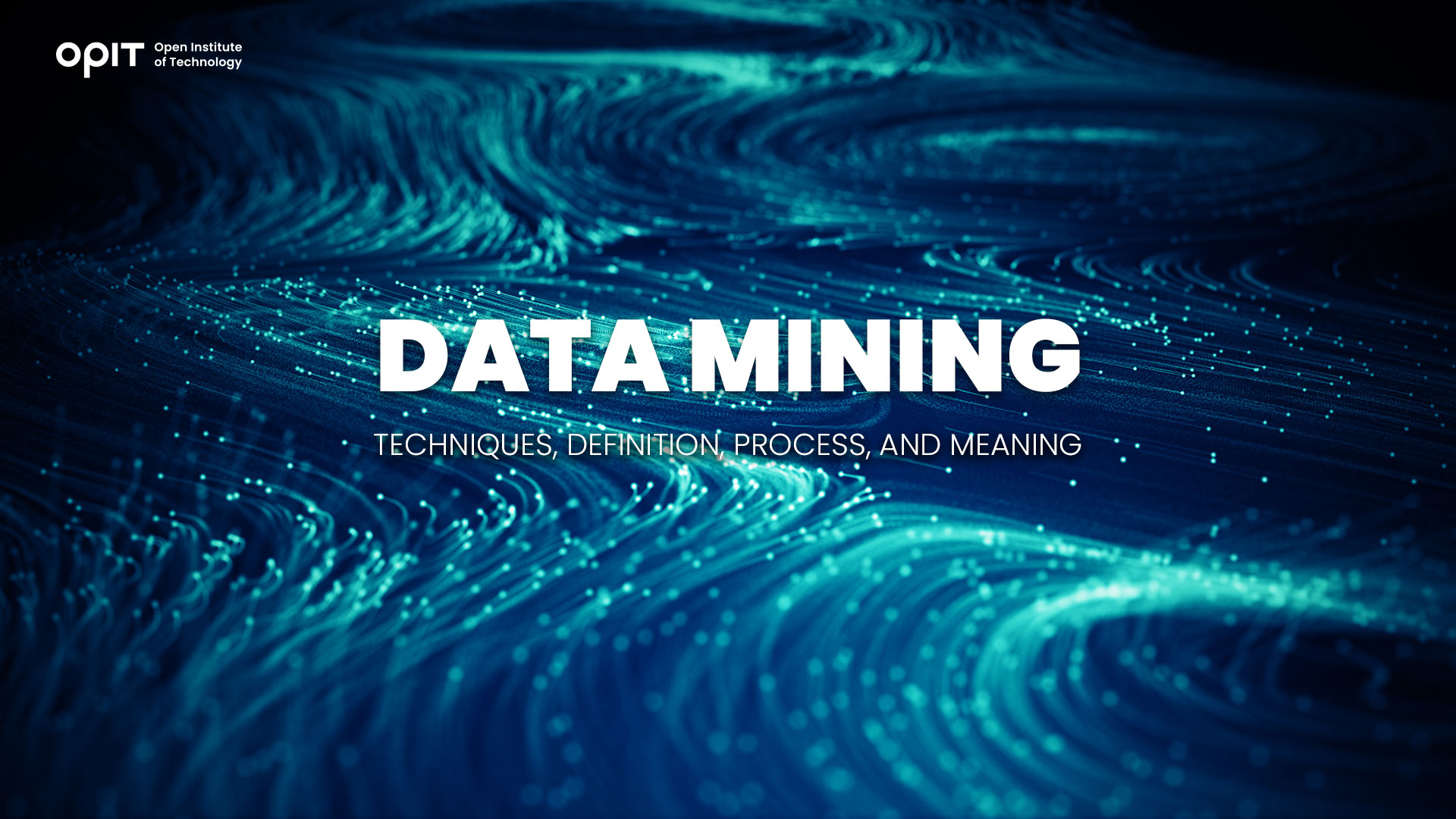

Think for a second about employees in diamond mines. Their job can often seem like trying to find a needle in a haystack. But once they find what they’re looking for, the feeling of accomplishment is overwhelming.
The situation is similar with data mining. Granted, you’re not on the hunt for diamonds (although that wouldn’t be so bad). The concept’s name may suggest otherwise, but data mining isn’t about extracting data. What you’re mining are patterns; you analyze datasets and try to see whether there’s a trend.
Data mining doesn’t involve you reading thousands of pages. This process is automatic (or at least semi-automatic). The patterns discovered with data mining are often seen as input data, meaning it’s used for further analysis and research. Data mining has become a vital part of machine learning and artificial intelligence as a whole. If you think this is too abstract and complex, you should know that data mining has found its purpose for every company. Investigating trends, prices, sales, and customer behavior is important for any business that sells products or services.
In this article, we’ll cover different data mining techniques and explain the entire process in more detail.
Data Mining Techniques
Here are the most popular data mining techniques.
Classification
As you can assume, this technique classifies something (datasets). Through classification, you can organize vast datasets into clear categories and turn them into classifiers (models) for further analysis.
Clustering
In this case, data is divided into clusters according to a certain criterion. Each cluster should contain similar data points that differ from data points in other clusters.
If we look at clustering from the perspective of artificial intelligence, we say it’s an unsupervised algorithm. This means that human involvement isn’t necessary for the algorithm to discover common features and group data points according to them.
Association Rule Learning
This technique discovers interesting connections and associations in large datasets. It’s pretty common in sales, where companies use it to explore customers’ behaviors and relationships between different products.
Regression
This technique is based on the principle that the past can help you understand the future. It explores patterns in past data to make assumptions about the future and make new observations.
Anomaly Detection
This is pretty self-explanatory. Here, datasets are analyzed to identify “ugly ducklings,” i.e., unusual patterns or patterns that deviate from the standard.
Sequential Pattern Mining
With this technique, you’re also on the hunt for patterns. The “sequential” indicates that you’re analyzing data where the values are in a sequence.
Text Mining
Text mining involves analyzing unstructured text, turning it into a structured format, and checking for patterns.
Sentiment Analysis
This data mining technique is also called opinion mining, and it’s very different from the methods discussed above. This complex technique involves natural language processing, linguistics, and speech analysis and wants to discover the emotional tone in a text.
Data Mining Process
Regardless of the technique you’re using, the data process consists of several stages that ensure accuracy, efficiency, and reliability.
Data Collection
As mentioned, data mining isn’t actually about identifying data but about exploring patterns within the data. To do that, you obviously need a dataset you want to analyze. The data needs to be relevant, otherwise you won’t get accurate results.
Data Preprocessing
Whether you’re analyzing a small or large dataset, the data within it could be in different formats or have inconsistencies or errors. If you want to analyze it properly, you need to ensure the data is uniform and organized, meaning you need to preprocess it.
This stage involves several processes:
- Data cleaning
- Data transformation
- Data reduction
Once you complete them, your data will be prepared for analysis.
Data Analysis
You’ve come to the “main” part of the data mining process, which consists of two elements:
- Model building
- Model evaluation
Model building represents determining the most efficient ways to analyze the data and identify patterns. Think of it this way: you’re asking questions, and the model should be able to provide the correct answers.
The next step is model evaluation, where you’ll step back and think about the model. Is it the right fit for your data, and does it meet your criteria?
Interpretation and Visualization
The journey doesn’t end after the analysis. Now it’s time to review the results and come to relevant conclusions. You’ll also need to present these conclusions in the best way possible, especially if you conducted the analysis for someone else. You want to ensure that the end-user understands what was done and what was discovered in the process.
Deployment and Integration
You’ve conducted the analysis, interpreted the results, and now you understand what needs to be changed. You’ll use the knowledge you’ve gained to elicit changes.
For example, you’ve analyzed your customers’ behaviors to understand why the sales of a specific product dropped. The results showed that people under the age of 30 don’t buy it as often as they used to. Now, you face two choices: You can either advertise the product and focus on the particular age group or attract even more people over the age of 30 if that makes more sense.
Applications of Data Mining
The concept of data mining may sound too abstract. However, it’s all around us. The process has proven invaluable in many spheres, from sales to healthcare and finance.
Here are the most common applications of data mining.
Customer Relationship Management
Your customers are the most important part of your business. After all, if it weren’t for them, your company wouldn’t have anyone to sell the products/services to. Yes, the quality of your products is one way to attract and keep your customers. But quality won’t be enough if you don’t value your customers.
Whether they’re buying a product for the first or the 100th time, your customers want to know you want to keep them. Some ways to do so are discounts, sales, and loyalty programs. Coming up with the best strategy can be challenging to say the least, especially if you have many customers belonging to different age groups, gender, and spending habits. With data mining, you can group your customers according to specific criteria and offer them deals that suit them perfectly.
Fraud Detection
In this case, you analyze data not to find patterns but to find something that stands out. This is what banks do to ensure no unwanted guests are accessing your account. But you can also see this fraud detection in the business world. Many companies use it to identify and remove fake accounts.
Market Basket Analysis
With data mining, you can get answers to an important question: “Which items are often bought together?” If this is on your mind, data mining can help. You can perform the association technique to discover the patterns (for example, milk and cereal) and use this valuable intel to offer your customers top-notch recommendations.
Healthcare and Medical Research
The healthcare industry has benefited immensely from data mining. The process is used to improve decision-making, generate conclusions, and check whether a treatment is working. Thanks to data mining, diagnoses have become more precise, and patients get more quality services.
As medical research and drug testing are large parts of moving the entire industry forward, data mining found its role here, too. It’s used to keep track of and reduce the risk of side effects of different medications and assist in administration.
Social Media Analysis
This is definitely one of the most lucrative applications. Social media platforms rely on it to pick up more information about their users to offer them relevant content. Thanks to this, people who use the same network will often see completely different posts. Let’s say you love dogs and often watch videos about them. The social network you’re on will recognize this and offer you even more dog videos. If you’re a cat person and avoid dog videos at all costs, the algorithm will “understand” this and offer you more videos starring cats.
Finance and Banking
Data mining analyzes markets to discover hidden patterns and make accurate predictions. The process is also used to check a company’s health and see what can be improved.
In banking, data mining is used to detect unusual transactions and prevent unauthorized access and theft. It can analyze clients and determine whether they’re suitable for loans (whether they can pay them back).
Challenges and Ethical Considerations of Data Mining
While it has many benefits, data mining faces different challenges:
- Privacy concerns – During the data mining process, sensitive and private information about users can come to light, thus jeopardizing their privacy.
- Data security – The world’s hungry for knowledge, and more and more data is getting collected and analyzed. There’s always a risk of data breaches that could affect millions of people worldwide.
- Bias and discrimination – Like humans, algorithms can be biased, but only if the sample data leads them toward such behavior. You can prevent this with precise data collection and preprocessing.
- Legal and regulatory compliance – Data mining needs to be conducted according to the letter of the law. If that’s not the case, the users’ privacy and your company’s reputation are at stake.
Track Trends With Data Mining
If you feel lost and have no idea what your next step should be, data mining can be your life support. With it, you can make informed decisions that will drive your company forward.
Considering its benefits, data mining will continue to be an invaluable tool in many niches.
Related posts

Source:
- Raconteur, published on November 06th, 2025
Many firms have conducted successful Artificial Intelligence (AI) pilot projects, but scaling them across departments and workflows remains a challenge. Inference costs, data silos, talent gaps and poor alignment with business strategy are just some of the issues that leave organisations trapped in pilot purgatory. This inability to scale successful experiments means AI’s potential for improving enterprise efficiency, decision-making and innovation isn’t fully realised. So what’s the solution?
Although it’s not a magic bullet, an AI operating model is really the foundation for scaling pilot projects up to enterprise-wide deployments. Essentially it’s a structured framework that defines how the organisation develops, deploys and governs AI. By bringing together infrastructure, data, people, and governance in a flexible and secure way, it ensures that AI delivers value at scale while remaining ethical and compliant.
“A successful AI proof-of-concept is like building a single race car that can go fast,” says Professor Yu Xiong, chair of business analytics at the UK-based Surrey Business School. “An efficient AI technology operations model, however, is the entire system – the processes, tools, and team structures – for continuously manufacturing, maintaining, and safely operating an entire fleet of cars.”
But while the importance of this framework is clear, how should enterprises establish and embed it?
“It begins with a clear strategy that defines objectives, desired outcomes, and measurable success criteria, such as model performance, bias detection, and regulatory compliance metrics,” says Professor Azadeh Haratiannezhadi, co-founder of generative AI company Taktify and professor of generative AI in cybersecurity at OPIT – the Open Institute of Technology.
Platforms, tools and MLOps pipelines that enable models to be deployed, monitored and scaled in a safe and efficient way are also essential in practical terms.
“Tools and infrastructure must also be selected with transparency, cost, and governance in mind,” says Efrain Ruh, continental chief technology officer for Europe at Digitate. “Crucially, organisations need to continuously monitor the evolving AI landscape and adapt their models to new capabilities and market offerings.”
An open approach
The most effective AI operating models are also founded on openness, interoperability and modularity. Open source platforms and tools provide greater control over data, deployment environments and costs, for example. These characteristics can help enterprises to avoid vendor lock-in, successfully align AI to business culture and values, and embed it safely into cross-department workflows.
“Modularity and platformisation…avoids building isolated ‘silos’ for each project,” explains professor Xiong. “Instead, it provides a shared, reusable ‘AI platform’ that integrates toolchains for data preparation, model training, deployment, monitoring, and retraining. This drastically improves efficiency and reduces the cost of redundant work.”
A strong data strategy is equally vital for ensuring high-quality performance and reducing bias. Ideally, the AI operating model should be cloud and LLM agnostic too.
“This allows organisations to coordinate and orchestrate AI agents from various sources, whether that’s internal or 3rd party,” says Babak Hodjat, global chief technology officer of AI at Cognizant. “The interoperability also means businesses can adopt an agile iterative process for AI projects that is guided by measuring efficiency, productivity, and quality gains, while guaranteeing trust and safety are built into all elements of design and implementation.”
A robust AI operating model should feature clear objectives for compliance, security and data privacy, as well as accountability structures. Richard Corbridge, chief information officer of Segro, advises organisations to: “Start small with well-scoped pilots that solve real pain points, then bake in repeatable patterns, data contracts, test harnesses, explainability checks and rollback plans, so learning can be scaled without multiplying risk. If you don’t codify how models are approved, deployed, monitored and retired, you won’t get past pilot purgatory.”
Of course, technology alone can’t drive successful AI adoption at scale: the right skills and culture are also essential for embedding AI across the enterprise.
“Multidisciplinary teams that combine technical expertise in AI, security, and governance with deep business knowledge create a foundation for sustainable adoption,” says Professor Haratiannezhadi. “Ongoing training ensures staff acquire advanced AI skills while understanding associated risks and responsibilities.”
Ultimately, an AI operating model is the playbook that enables an enterprise to use AI responsibly and effectively at scale. By drawing together governance, technological infrastructure, cultural change and open collaboration, it supports the shift from isolated experiments to the kind of sustainable AI capability that can drive competitive advantage.
In other words, it’s the foundation for turning ambition into reality, and finally escaping pilot purgatory for good.

The Open Institute of Technology (OPIT) is the perfect place for those looking to master the core skills and gain the fundamental knowledge they need to enter the exciting and dynamic environment of the tech industry. While OPIT’s various degrees and courses unlock the doors to numerous careers, students may not know exactly which line of work they wish to enter, or how, exactly, to take the next steps.
That’s why, as well as providing exceptional online education in fields like Responsible AI, Computer Science, and Digital Business, OPIT also offers an array of career-related services, like the Peer Career Mentoring Program. Designed to provide the expert advice and support students need, this program helps students and alumni gain inspiration and insight to map out their future careers.
Introducing the OPIT Peer Career Mentoring Program
As the name implies, OPIT’s Peer Career Mentoring Program is about connecting students and alumni with experienced peers to provide insights, guidance, and mentorship and support their next steps on both a personal and professional level.
It provides a highly supportive and empowering space in which current and former learners can receive career-related advice and guidance, harnessing the rich and varied experiences of the OPIT community to accelerate growth and development.
Meet the Mentors
Plenty of experienced, expert mentors have already signed up to play their part in the Peer Career Mentoring Program at OPIT. They include managers, analysts, researchers, and more, all ready and eager to share the benefits of their experience and their unique perspectives on the tech industry, careers in tech, and the educational experience at OPIT.
Examples include:
- Marco Lorenzi: Having graduated from the MSc in Applied Data Science and AI program at OPIT, Marco has since progressed to a role as a Prompt Engineer at RWS Group and is passionate about supporting younger learners as they take their first steps into the workforce or seek career evolution.
- Antonio Amendolagine: Antonio graduated from the OPIT MSc in Applied Data Science and AI and currently works as a Product Marketing and CRM Manager with MER MEC SpA, focusing on international B2B businesses. Like other mentors in the program, he enjoys helping students feel more confident about achieving their future aims.
- Asya Mantovani: Asya took the MSc in Responsible AI program at OPIT before taking the next steps in her career as a Software Engineer with Accenture, one of the largest IT companies in the world, and a trusted partner of the institute. With a firm belief in knowledge-sharing and mutual support, she’s eager to help students progress and succeed.
The Value of the Peer Mentoring Program
The OPIT Peer Career Mentoring Program is an invaluable source of support, inspiration, motivation, and guidance for the many students and graduates of OPIT who feel the need for a helping hand or guiding light to help them find the way or make the right decisions moving forward. It’s a program built around the sharing of wisdom, skills, and insights, designed to empower all who take part.
Every student is different. Some have very clear, fixed, and firm objectives in mind for their futures. Others may have a slightly more vague outline of where they want to go and what they want to do. Others live more in the moment, focusing purely on the here and now, but not thinking too far ahead. All of these different types of people may need guidance and support from time to time, and peer mentoring provides that.
This program is also just one of many ways in which OPIT bridges the gaps between learners around the world, creating a whole community of students and educators, linked together by their shared passions for technology and development. So, even though you may study remotely at OPIT, you never need to feel alone or isolated from your peers.
Additional Career Services Offered by OPIT
The Peer Career Mentoring Program is just one part of the larger array of career services that students enjoy at the Open Institute of Technology.
- Career Coaching and Support: Students can schedule one-to-one sessions with the institute’s experts to receive insightful feedback, flexibly customized to their exact needs and situation. They can request resume audits, hone their interview skills, and develop action plans for the future, all with the help of experienced, expert coaches.
- Resource Hub: Maybe you need help differentiating between various career paths, or seeing where your degree might take you. Or you need a bit of assistance in handling the challenges of the job-hunting process. Either way, the OPIT Resource Hub contains the in-depth guides you need to get ahead and gain practical skills to confidently move forward.
- Career Events: Regularly, OPIT hosts online career event sessions with industry experts and leaders as guest speakers about the topics that most interest today’s tech students and graduates. You can join workshops to sharpen your skills and become a better prospect in the job market, or just listen to the lessons and insights of the pros.
- Internship Opportunities: There are few better ways to begin your professional journey than an internship at a top-tier company. OPIT unlocks the doors to numerous internship roles with trusted institute partners, as well as additional professional and project opportunities where you can get hands-on work experience at a high level.
In addition to the above, OPIT also teams up with an array of leading organizations around the world, including some of the biggest names, including AWS, Accenture, and Hype. Through this network of trust, OPIT facilitates students’ steps into the world of work.
Start Your Study Journey Today
As well as the Peer Career Mentoring Program, OPIT provides numerous other exciting advantages for those who enroll, including progressive assessments, round-the-clock support, affordable rates, and a team of international professors from top universities with real-world experience in technology. In short, it’s the perfect place to push forward and get the knowledge you need to succeed.
So, if you’re eager to become a tech leader of tomorrow, learn more about OPIT today.
Have questions?
Visit our FAQ page or get in touch with us!
Write us at +39 335 576 0263
Get in touch at hello@opit.com
Talk to one of our Study Advisors
We are international
We can speak in:


